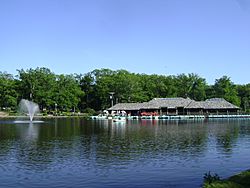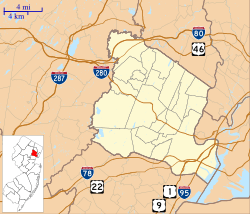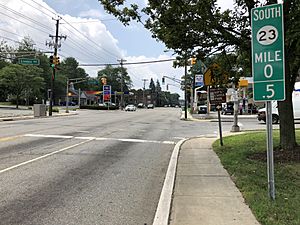Verona, New Jersey facts for kids
Quick facts for kids
Verona, New Jersey
|
|||
|---|---|---|---|
|
Township
|
|||

The Verona Park Boathouse, viewed from the north-west shore of Verona Park Lake
|
|||
|
|||
| Country | |||
| State | |||
| County | Essex | ||
| Settled | 1702 | ||
| Incorporated | April 30, 1907 | ||
| Named for | Verona, Italy | ||
| Government | |||
| • Type | Faulkner Act (council–manager) | ||
| • Body | Township Council | ||
| Area | |||
| • Total | 2.82 sq mi (7.29 km2) | ||
| • Land | 2.79 sq mi (7.24 km2) | ||
| • Water | 0.02 sq mi (0.05 km2) 0.74% | ||
| Area rank | 353rd of 565 in state 18th of 22 in county |
||
| Elevation | 335 ft (102 m) | ||
| Population
(2020)
|
|||
| • Total | 14,572 | ||
| • Estimate
(2024)
|
14,779 | ||
| • Rank | 182nd of 565 in state 14th of 22 in county |
||
| • Density | 5,215.5/sq mi (2,013.7/km2) | ||
| • Density rank | 110th of 565 in state 13th of 22 in county |
||
| Time zone | UTC−05:00 (Eastern (EST)) | ||
| • Summer (DST) | UTC−04:00 (Eastern (EDT)) | ||
| ZIP Code |
07044
|
||
| Area code(s) | 973 exchanges: 239, 571, 857 | ||
| FIPS code | 3401375815 | ||
| GNIS feature ID | 1729716 | ||
Verona is a township in Essex County, New Jersey. It is located in the United States. In 2020, about 14,572 people lived there. This was an increase from 13,332 people in 2010.
Contents
History of Verona
Verona and some nearby towns were once part of a larger area. This area was known as the Horseneck Tract.
Early Settlement in the 1700s
In 1702, a group of settlers bought a large piece of land. They bought it from the Lenape Native Americans. This land was called Horseneck. It looked like the neck and head of a horse. Many towns today, like Verona, are part of this original Horseneck area.
After the Revolutionary War, Horseneck became "Caldwell Township." This was to honor James Caldwell. He was a local pastor and war hero.
Verona's Growth in the 1800s
In the 1800s, the area that is now Verona was called Vernon Valley. But the name Vernon was already used by the postal service. So, Verona was chosen instead. The name Verona comes from Verona, Italy.
Over time, people in Verona wanted more control over their local government. They needed schools and churches closer to them. They also had issues with water and road repairs.
Because of these reasons, Verona decided to separate. On February 17, 1892, Verona officially became "Verona Township."
Becoming a Borough in the 1900s
Verona continued to grow. In 1907, Verona Township and Verona Borough separated. This happened because Verona Borough wanted its own public services. The new borough was approved on April 18, 1907.
In 1908, Verona Township changed its name. It became Cedar Grove Township. This was to show it was different from the new Verona Borough.
Later, in 1981, Verona Borough changed back to a township. This was to get more government funding. Many towns in New Jersey did this. Today, Verona is officially called the "Township of Verona."
Geography and Climate
Verona covers about 2.82 square miles (7.29 square kilometers). Most of this is land. Only a small part is water.
Location and Surroundings
Verona is located between two mountains. These are the First and Second Watchung Mountains. A small river, the Peckman, flows through the valley. It goes towards the Passaic River.
Nearby towns include Cedar Grove, Essex Fells, and Montclair.
Verona's Weather Patterns
Verona has a humid continental climate. This means it has warm, humid summers. Winters are moderately cold. The weather is a bit cooler than in New York City. This is because Verona is higher up and further from the ocean.
January is usually the coldest month. High temperatures are around 30s Fahrenheit. July is the warmest month. High temperatures are in the mid-80s. Verona gets a good amount of rain. Snow is common from December to March. Big snowstorms, called nor'easters, can bring a lot of snow.
| Climate data for Verona | |||||||||||||
|---|---|---|---|---|---|---|---|---|---|---|---|---|---|
| Month | Jan | Feb | Mar | Apr | May | Jun | Jul | Aug | Sep | Oct | Nov | Dec | Year |
| Mean daily maximum °F (°C) | 36 (2) |
40 (4) |
49 (9) |
60 (16) |
71 (22) |
79 (26) |
84 (29) |
82 (28) |
75 (24) |
64 (18) |
53 (12) |
41 (5) |
61 (16) |
| Mean daily minimum °F (°C) | 19 (−7) |
21 (−6) |
29 (−2) |
38 (3) |
48 (9) |
57 (14) |
62 (17) |
60 (16) |
52 (11) |
41 (5) |
33 (1) |
24 (−4) |
40 (5) |
| Average precipitation inches (mm) | 4.10 (104) |
3.05 (77) |
4.13 (105) |
4.60 (117) |
4.93 (125) |
4.48 (114) |
4.74 (120) |
4.39 (112) |
5.11 (130) |
4.02 (102) |
4.23 (107) |
4.12 (105) |
51.9 (1,320) |
Population and People
Verona's population has changed over the years. In 1910, there were 1,675 people. By 2020, the population grew to 14,556. The estimated population for 2024 was 14,779.
Diversity in Verona
Verona is a diverse community. In 2020, about 79.54% of the population was White (not Hispanic). About 2.22% were Black or African American. About 4.78% were Asian. People of Hispanic or Latino background made up 9.82% of the population.
Economy and Business
Annin & Co. is the world's oldest and largest flag maker. Its main factory was in Verona from 1916 to 2013. Annin makes flags for the United Nations and the U.S. Government.
Annin flags have been used in many historic moments. These include on Iwo Jima, at the North and South Poles, and on Mount Everest. They also made 186 small flags for the Apollo 11 mission to the Moon.
Parks and Recreation
Verona has many parks and places for fun activities.
- Eagle Rock Reservation: A large forest reserve with beautiful views.
- Everett Field: A park for baseball and football.
- Hilltop Reservation: This park opened in 2003. It has many trails for hiking and mountain biking.
- Kip's Castle Park: This park has a castle-style mansion. It also has a large carriage house.
- Verona Park: The fifth-largest park in the county. It was designed by the same person who designed Central Park in New York City.
- Lenape Trail: A long trail that runs through Verona Park.
- Verona Community Center: Built in 1997, it has a gym, game room, and ballroom.
- Veteran's Field: Has two softball/baseball fields.
- Centennial Field: An artificial turf field that opened in 2007.
- Liberty Field: Another artificial turf field, opened in 2015.
- Freedom Field: An artificial turf field, opened in 2016.
- Verona Pool: Features an Olympic-size swimming pool with water slides. It also has a wading pool for younger kids. There are courts for volleyball, basketball, and racquetball.
- West Essex Trail: A 2.84-mile (4.57 km) trail for walking and biking.
Government and Politics
Verona has a special type of local government. It is called the Council-Manager form. Five people are on the Township Council. They are elected to four-year terms. The council chooses a mayor and deputy mayor from its members.
As of 2025, Christopher Tamburro is the Mayor. Jack McEvoy is the Deputy Mayor. Kevin O'Sullivan is the Township Manager. He manages the daily operations of Verona.
Voting in Verona
In the 2020 presidential election, Democrats received more votes in Verona. In the 2016 election, Democrats also received more votes. However, in the 2008 and 2004 presidential elections, Republicans received more votes.
Past Mayors of Verona
| Current and Previous Mayors of Verona, New Jersey | |||||||||||||||||||||||||||||||||||||||||||||||||||||||||||||||||||||||||||||||||||||||||||||||||||||||||||||||||||||||||||
|---|---|---|---|---|---|---|---|---|---|---|---|---|---|---|---|---|---|---|---|---|---|---|---|---|---|---|---|---|---|---|---|---|---|---|---|---|---|---|---|---|---|---|---|---|---|---|---|---|---|---|---|---|---|---|---|---|---|---|---|---|---|---|---|---|---|---|---|---|---|---|---|---|---|---|---|---|---|---|---|---|---|---|---|---|---|---|---|---|---|---|---|---|---|---|---|---|---|---|---|---|---|---|---|---|---|---|---|---|---|---|---|---|---|---|---|---|---|---|---|---|---|---|---|
|
Education in Verona
Verona has public and private schools.
Public Schools in Verona
The Verona Public Schools district serves students from pre-kindergarten to twelfth grade. There are six schools in the district:
- Brookdale Avenue School (grades K–4)
- Frederic N. Brown School (grades K–4)
- Forest Avenue School (grades K–4)
- Laning Avenue School (grades Pre-K–4)
- Henry B. Whitehorne Middle School (grades 5–8)
- Verona High School (grades 9–12)
The high school mascot is the "Hillbilly". The mascot's image has changed over time. It now shows a fishing pole and a dog. Verona High School was ranked 31st among public high schools in New Jersey in 2020.
Private Schools in Verona
- Our Lady of the Lake Catholic School: Founded in 1924, it serves students from pre-school to eighth grade. It has been recognized as a "National Blue Ribbon School."
- Academy360 Lower School: This school helps children aged 3–21. It is for those who have learning, language, and social challenges. The school moved to Verona in 1999.
Transportation in Verona
Verona has several roads and public transportation options.
Roads and Highways
Verona has about 37.83 miles of roads. Major roads include Route 23 and CR 506. Other highways nearby are the Garden State Parkway and Interstate 80.
Public Transportation Options
NJ Transit buses (routes 11 and 29) connect Verona to Newark. DeCamp Bus Lines also offers service to Midtown Manhattan.
Train stations are in nearby towns like Little Falls and Montclair. Verona used to have its own train service. The old Verona station freight shed is now a historic landmark.
Verona is about 14.3 miles (23.0 km) from Newark Liberty International Airport.
Community Services
- The Verona Fire Department is a volunteer department. It has over 60 firefighters. They have two stations and many fire trucks.
- The Verona Rescue Squad is also volunteer. It has three ambulances. It was formed in 1927.
- Bloomfield Avenue is the main street in Verona. It has the Town Hall, Library, and many shops.
- During the American Revolutionary War, George Washington used Eagle Rock Reservation. It was a lookout point to watch British troops.
- The Essex Mountain Sanatorium was a hospital for people with tuberculosis. It opened in 1902 and closed in 1977.
Notable People from Verona
Many interesting people have lived in Verona.
- Tommy Albelin (born 1964), a hockey player for the New Jersey Devils.
- Kevin Bannon (born 1957), a former college basketball coach.
- John C. Bogle (1929–2019), who started The Vanguard Group.
- Bill Bradley (born 1943), an Olympic gold medalist and professional basketball player. He was also a US Senator.
- Lorinda Cherry (1944–2022), a computer scientist who worked at Bell Labs.
- Marion Crecco (1930–2015), a member of the New Jersey General Assembly.
- Peter David (born 1956), a science fiction and fantasy author.
- Dan DePalma (born 1989), a wide receiver in the Canadian Football League.
- Mary Dunleavy (born 1966), an opera singer.
- Anthony Fasano (born 1984), a tight end for the Tennessee Titans.
- David Festa (born 2000), a professional baseball pitcher.
- Jed Graef (born 1942), a swimmer who won a gold medal at the 1964 Olympics.
- Barbara J. Griffiths (born 1949), a diplomat and former U.S. Ambassador to Iceland.
- Fred Hill Jr. (born 1959), coached the Rutgers Scarlet Knights men's basketball team.
- Fred Hill Sr. (1934–2019), a former baseball coach for the Rutgers Scarlet Knights baseball team.
- Philip E. Hoffman (1908–1993), a lawyer and ambassador.
- Fred Krupp, president of the Environmental Defense Fund.
- John MacLean (born 1964), a hockey player and coach for the New Jersey Devils.
- Phyllis Mangina (born 1959), a college basketball coach.
- Elmer Matthews (1927–2015), a lawyer and politician.
- Nicole McLaughlin, an artist known for upcycled fashion.
- Jay Mohr (born 1970), an actor, comedian, and radio personality.
- Jon Okafor (born 1989), a professional soccer player.
- Henry Orenstein (1923–2021), a professional poker player.
- Kal Parekh, an actor who appeared in the TV series Pan Am.
- Kenneth Posner, a lighting designer for Broadway shows like Wicked.
- Brian Rafalski (born 1973), a hockey player for the New Jersey Devils.
- Saul Robbins (1922–2010), a toy manufacturer.
- John Roosma (1900–1983), a famous college basketball player.
- Joel Rosenblatt, a musician and drummer for the band Spyro Gyra.
- David M. Satz Jr. (1926–2009), a lawyer who served as U.S. Attorney.
- Brenda Shaughnessy (born 1970), a poet.
- Donald J. Strait (1918–2015), a flying ace in World War II.
- Craig Morgan Teicher (born 1979), an author and poet.
- Rod Trafford (born 1978), a former NFL tight end.
- Bruce Wands (1949–2022), an educator, artist, and musician.
- Chris Wylde (born 1976), an actor and comedian.
See also
 In Spanish: Verona (Nueva Jersey) para niños
In Spanish: Verona (Nueva Jersey) para niños








